I should remind myself not to listen to the media (even the public broadcaster) when…
Australia labour market weaker with participation falling
The latest labour force data released today by the Australian Bureau of Statistics – Labour Force data – for October 2017 shows that total employment growth was weak although there was relatively good full-time employment growth. Unemployment (and the rate) fell, but only because the participation rate fell. If not, then the unemployment rate would have risen marginally. So no signs of a sustained growth path is emerging. Broad labour underutilisation (underemployment and unemployment) was at 13.3 per cent summing to 1,724 thousand persons, which tells you that there is still considerable slack in the labour market. The teenage labour market deteriorated in October although this cohort shared in the full-time employment growth, which is a good outcome. Overall, my assessment is that there is no discernible trend in the Australian labour market. It shows signs of strength one month, and then backs away from that the next. We are not in a position to say that there is a sustained growth path ahead.
The summary ABS Labour Force (seasonally adjusted) estimates for October 2017 are:
- Employment increased 3,700 (0.03 per cent) – full-time employment increased 24,300 and part-time employment decreased 20,700.
- Unemployment decreased 8,100 to 701,500.
- The official unemployment rate decreased 0.1 points to 5.4 per cent.
- The participation rate decreased 0.1 points to 65.1 per cent. It still remains below its December 2010 peak (recent) of 65.8 per cent.
- Aggregate monthly hours worked increased 4.6 million hours (0.3 per cent).
- The monthly labour underutilisation data shows that underemployment was estimated to be 8.2 per cent of the labour force (steady); the total labour underutilisation rate (unemployment plus underemployment) was 13.3 per cent (down from 13.6 per cent); there were 1,057.9 thousand persons underemployed and a total of 1,724 thousand workers either unemployed or underemployed.
Employment growth – barely a whimper
Employment increased by a minuscule 3,700 (0.03 per cent) – full-time employment increased 24,300 and part-time employment decreased 20,700.
While the growth in full-time employment is a good outcome, the overall employment growth was very weak and follows a fairly weak result the previous month.
A slowdown is looming.
We observed a zig-zag pattern in total employment growth up until the end of 2016. The oscillating pattern has continued into 2017 but the level has risen above the zero line. There is still a switching pattern around the zero line for full-time and part-time that is evident although over the last two months both employment components have been positive.
The following graph shows the month by month growth in full-time (blue columns), part-time (grey columns) and total employment (green line) for the 24 months to October 2017 using seasonally adjusted data.
It gives you a good impression of just how flat employment growth has been over the last 2 years. The positive note is that there has been four stronger full-time employment outcomes in the last eight months.
The following table provides an accounting summary of the labour market performance over the last six months. The monthly data is highly variable so this Table provides a longer view which allows for a better assessment of the trends.
Full-time employment has risen risen by 180 thousand jobs (net) over the last 6 months, while part-time employment has fallen by 4.4 thousand jobs. This reverses the 2016 and early 2017 bias in favour of part-time work.
Overall there have been 175.6 thousand jobs (net) added in Australia over the last six months while the labour force has increased by just 145.8 thousand. The result has been that unemployment has fallen by 29.8 thousand.
Given the variation in the labour force estimates, it is sometimes useful to examine the Employment-to-Population ratio (%) because the underlying population estimates (denominator) are less cyclical and subject to variation than the labour force estimates. This is an alternative measure of the robustness of activity to the unemployment rate, which is sensitive to those labour force swings.
The following graph shows the Employment-to-Population ratio, since February 2008 (the low-point unemployment rate of the last cycle).
It dived with the onset of the GFC, recovered under the boost provided by the fiscal stimulus packages but then went backwards again as the last Federal government imposed fiscal austerity in a hare-brained attempt at achieving a fiscal surplus.
The ratio began rising in December 2014 which suggested to some that the labour market had bottomed out and would improve slowly as long as there are no major policy contractions or cuts in private capital formation.
The series turned again as overall economic activity weakened. Over the last few months it has improved again.
The series fell by 0.1 points in October 2017 to 61.6 per cent and remains a 1.3 percentage points below the April 2008 peak of 62.9 per cent.
Teenage labour market – sharp deterioration in total employment October 2017
The modest overall employment growth in October was accompanied by a sharp deterioration in the teenage labour market.
While full-time teenage employment grew by 6.2 thousand jobs in October 2017, which is a good sign; part-time employment fell by 15.4 thousand.
As a result, total employment fell by 9.2 thousand (net) in October 2017.
The following graph shows the distribution of net employment creation in the last month by full-time/part-time status and age/gender category (15-19 year olds and the rest)
Over the last 12 months, teenagers have gained 13.9 thousand (net) jobs overall while the rest of the labour force have gained 341.8 thousand net jobs. Teenagers are around 6.1 per cent of the total labour force.
Full-time employment for teenagers over the last 12 months has risen by 17.1 thousand while part-time employment employment has fallen by 3.2 thousand.
The following graph shows the change in aggregates over the last 12 months.
In terms of the current cycle, which began after the last low-point unemployment rate month (February 2008), the following results are relevant:
1. Since February 2008, there have been only 1,649.5 thousand (net) jobs added to the Australian economy but teenagers have lost a staggering 96.3 thousand over the same period.
2. Since February 2008, teenagers have lost 111.5 thousand full-time jobs (net).
3. Even in the traditionally, concentrated teenage segment – part-time employment, teenagers have gained only 15.3 thousand jobs (net) even though 885.5 thousand part-time jobs have been added overall.
To put the teenage employment situation in a scale context (relative to their size in the population) the following graph shows the Employment-Population ratios for males, females and total 15-19 year olds since February 2008.
You can interpret this graph as depicting the loss of employment relative to the underlying population of each cohort. We would expect (at least) that this ratio should be constant if not rising somewhat (depending on school participation rates).
The facts are that the absolute loss of jobs reported above is depicting a very difficult situation for our teenagers. Males, in particular, have lost out severely as a result of the economy being deliberately stifled by austerity policy positions.
In the latter months of 2015, with the part-time employment situation improving, there was some reversal in the downward trends in these ratios.
But despite some improvement in recent months, there was a sharp fall in the ratios in October 2017 – males, 0.5 points; females, -0.6 points, and total, -0.6 points, which doesn’t bode well.
The male ratio has fallen by 12 percentage points since February 2008, the female ratio has fallen by 4.7 percentage points and the overall teenage employment-population ratio has fallen by 8.4 percentage points.
The other staggering statistic relating to the teenage labour market is the decline in the participation rate since the beginning of 2008 when it peaked in January at 61.4 per cent.
In October 2017, the participation rate fell 1.1 points to 53 per cent.
But the difference between the 2008 level, amounts to an additional 127 thousand teenagers who have dropped out of the labour force as a result of the weak conditions since the crisis.
If we added them back into the labour force the teenage unemployment rate would be 28.6 per cent rather than the official estimate for October 2017 of 17.1 per cent.
Some may have decided to return to full-time education and abandoned their plans to work. But the data suggests the official unemployment rate is significantly understating the actual situation that teenagers face in the Australian labour market.
Overall, the performance of the teenage labour market remains extremely poor. It doesn’t rate much priority in the policy debate, which is surprising given that this is our future workforce in an ageing population. Future productivity growth will determine whether the ageing population enjoys a higher standard of living than now or goes backwards.
I continue to recommend that the Australian government immediately announce a major public sector job creation program aimed at employing all the unemployed 15-19 year olds, who are not in full-time education or a credible apprenticeship program.
Unemployment decreased 8,100 to 701,500
The official unemployment rate decreased 0.1 points at 5.4 per cent in October 2017, largely because the participation rate fell by 0.1 points (see below).
Even though the decline in unemployment over the last several months is a good outcome, the labour market still has significant excess capacity available.
The following graph shows the national unemployment rate from February 1978 to October 2017. The longer time-series helps frame some perspective to what is happening at present.
After falling steadily as the fiscal stimulus pushed growth along, the unemployment rate slowly trended up for some months.
It is now still 0.6 points above the level it fell to as a result of the fiscal stimulus and 1.6 points above the level reached before the GFC began.
Broad labour underutilisation – at 13.3 per cent
The ABS publishes monthly and quarterly labour underutilisation data. The quarterly data will be updated next month (for the November-quarter 2017).
The monthly (unadjusted series) tells us:
1. Underemployment was estimated to be 8.2 per cent of the labour force (steady).
2. The total labour underutilisation rate (unemployment plus underemployment) was 13.3 per cent (down from 13.6 per cent).
3. There were 1,057.9 thousand persons underemployed and a total of 1,724 thousand workers either unemployed or underemployed.
So a reduction in broad underutilisation in October was largely driven by the drop in participation (see below).
In terms of the quarterly data, the following graph plots the history of quarterly (seasonally-adjusted) underemployment in Australia since February 1978 to the May-quarter 2017.
The next graph shows the evolution of the broad underutilisation rate over the same period. You can see the three cyclical peaks corresponding to the 1982, 1991 recessions and the more recent downturn.
Unemployment was a higher proportion of the two earlier peaks but underemployment now dominates the current cycle (just).
The other difference between now and the two earlier cycles is that the recovery triggered by the fiscal stimulus in 2008-09 did not persist and as soon as the ‘fiscal surplus’ fetish kicked in in 2012, things went backwards very quickly.
The two earlier peaks were sharp but steadily declined. The last peak fell away on the back of the stimulus but turned again when the stimulus was withdrawn.
If hidden unemployment (given the depressed participation rate) is added to the broad ABS figure the best-case (conservative) scenario would see a underutilisation rate well above 15 per cent at present. Please read my blog – Australian labour underutilisation rate is at least 13.4 per cent – for more discussion on this point.
The next quarterly update will be for the November-quarter 2017 and will be published published in the December 2017 Labour Force release. In between those releases, the monthly estimates guide our thinking.
Aggregate participation rate – fell 0.1 points to 65.1 per cent
This is the first decline in the participation rate since February 2017 and could indicate a slowing economy, especially given the weak employment growth. Time will tell.
Unemployment fell by 8,100 this month but if the participation rate had not fallen in October 2017, total unemployment and the unemployment rate would have risen.
By how much?
The labour force is a subset of the working-age population (those above 15 years old). The proportion of the working-age population that constitutes the labour force is called the labour force participation rate. Thus changes in the labour force can impact on the official unemployment rate, and, as a result, movements in the latter need to be interpreted carefully. A rising unemployment rate may not indicate a recessing economy.
The labour force can expand as a result of general population growth and/or increases in the labour force participation rates.
What would have the unemployment rate been had the participation rate not fallen by 0.1 points in October 2017?
The following Table shows the breakdown in the changes to the main aggregates (Labour Force, Employment and Unemployment) and the impact of the rise in the participation rate.
In October 2017, employment rose by 3.7 thousand (net) jobs and the labour force fell by 4.5 thousand. As a result, unemployment fell by 8.1 thousand.
In other words, unemployment fell because the labour force shrank and employment grew.
The falling labour force in October 2017 was the outcome of two separate factors:
- The underlying population growth added 15.2 thousand persons to the labour force. The population growth impact on the labour force aggregate is relatively steady from month to month but has slowed in recent months; and
- The fall in the participation rate meant that there were 19.7 thousand workers dropping out of the labour force (relative to what would have occurred had the participation rate remained unchanged).
- The net result was the fall in the labour force of 4.5 thousand (rounded).
If the participation rate had not have fallen, total unemployment, at the current employment level, would have been 721.2 thousand rather than the official count of 701.5 thousand as recorded by the ABS – a difference of 19.7 thousand workers (the ‘participation effect’).
Thus, without the fall in the participation rate in October 2017, the unemployment rate would have been 5.5 per cent (rounded) rather than its current value of 5.4 per cent.
The conclusion is that hidden unemployment rose slightly in October 2017.
There is considerable monthly fluctuation in the participation rate but the current rate of 65.1 per cent is still well below its most recent peak in November 2010 of 65.8 per cent.
What would the unemployment rate be if the participation rate was at the last November 2010 peak level value?
The following graph tells us what would have happened if the participation rate had been constant over the period November 2010 to October 2017. The blue line is the official unemployment rate since its most recent low-point of 4 per cent in February 2008.
The red line starts at November 2010 (the peak participation month). It is computed by adding the workers that left the labour force as employment growth faltered (and the participation rate fell) back into the labour force and assuming they would have been unemployed. At present, this cohort is likely to comprise a component of the hidden unemployed (or discouraged workers).
With the rise in participation in recent months, the red line fell quite sharply, which was a good sign. That decline was arrested in October 2017.
1. Total official unemployment in October 2017 was estimated to be 701.5 thousand.
2. Unemployment would be 835.7 thousand if participation rate was at its November 2010 peak.
3. The unemployment rate would now be 6.4 per cent rather than the official October 2017 estimate of 5.4 per cent.
The difference between the two numbers mostly reflects, the change in hidden unemployment (discouraged workers) since November 2010. These workers would take a job immediately if offered one but have given up looking because there are not enough jobs and as a consequence the ABS classifies them as being Not in the Labour Force.
There has been some change in the age composition of the labour force (older workers with low participation rates becoming a higher proportion) but this only accounts for less than 1/3 of the shift. The rest is undoubtedly accounted for by the rise in hidden unemployment.
Note, the gap between the blue and red lines doesn’t sum to total hidden unemployment unless November 2010 was a full employment peak, which it clearly was not. The interpretation of the gap is that it shows the extra hidden unemployed since that time.
This gap shrinks as participation rises relative to the November 2010 peak.
Hours worked – increased 4.6 million hours (0.3 per cent)
Over the last three months we have seen swings in both directions.
This month there was a modest rise in hours worked as a result of the growth in full-time employment – even though total employment growth was weak.
The following graph shows the monthly growth (in per cent) over the last 24 months. The dark linear line is a simple regression trend of the monthly change – which depicts an upward trend – driven mostly by the outlier in May 2017.
You can see the pattern of the change in working hours is also portrayed in the employment graph – zig-zagging across the zero growth line.
Conclusion
My standard monthly warning: we always have to be careful interpreting month to month movements given the way the Labour Force Survey is constructed and implemented.
Today’s figures show that the Australian labour market improved slightly in October 2017, but that assessment has to be qualified against the fact that participation fell and employment growth was weak.
The only reason I say it improved is because the growth in full-time employment was relatively robust.
Unemployment fell due to the falling participation rate rather than the strength of employment growth.
The teenage labour market deteriorated in October 2017, and remains in a poor state. The positive sign was that they shared in the overall full-time employment growth but lost a lot of part-time jobs.
Overall, my assessment is that there is no discernible trend in the Australian labour market. It shows signs of strength one month, and then backs away from that the next.
We are not in a position to say that there is a sustained growth path ahead.
That is enough for today!
(c) Copyright 2017 William Mitchell. All Rights Reserved.
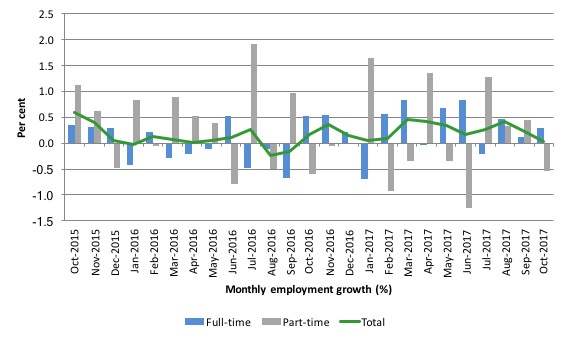
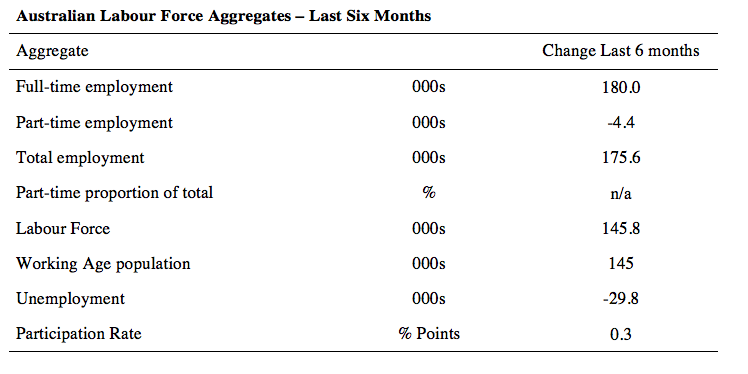
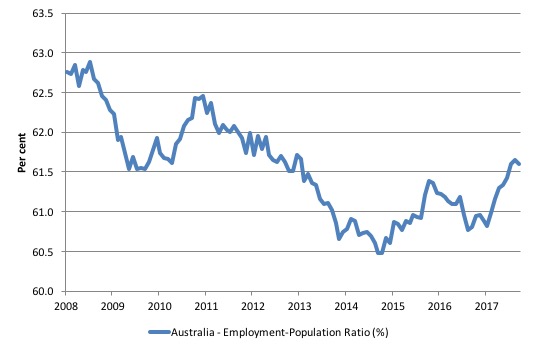
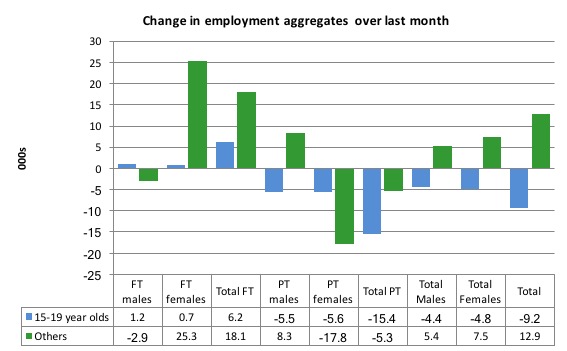
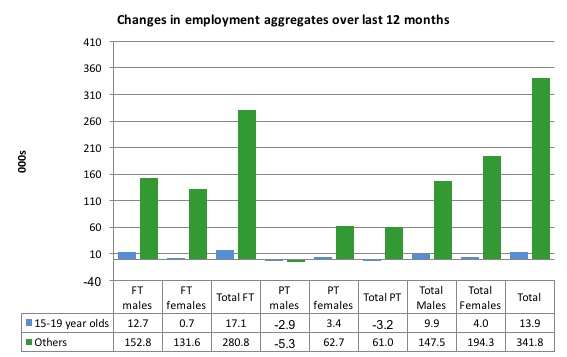
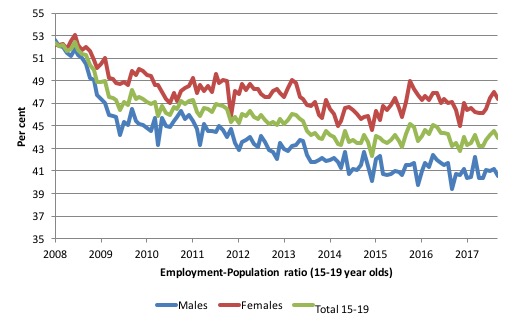
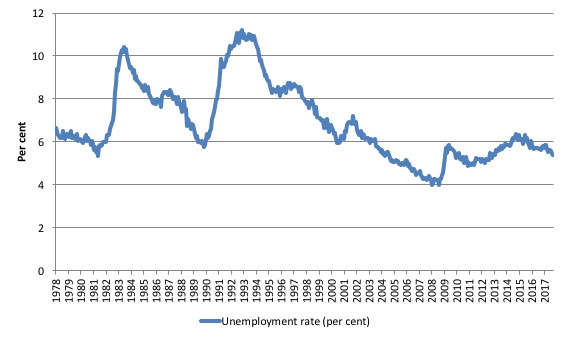
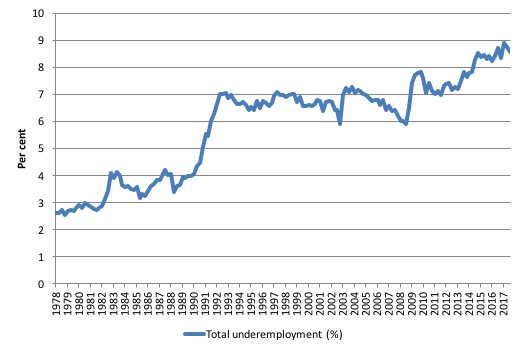
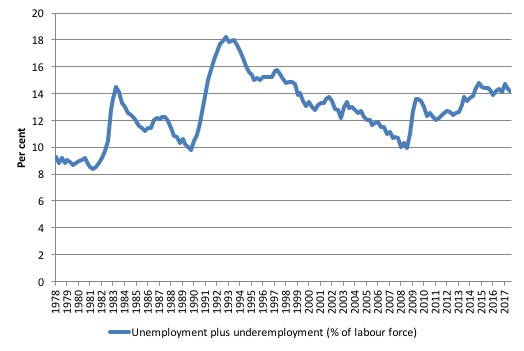
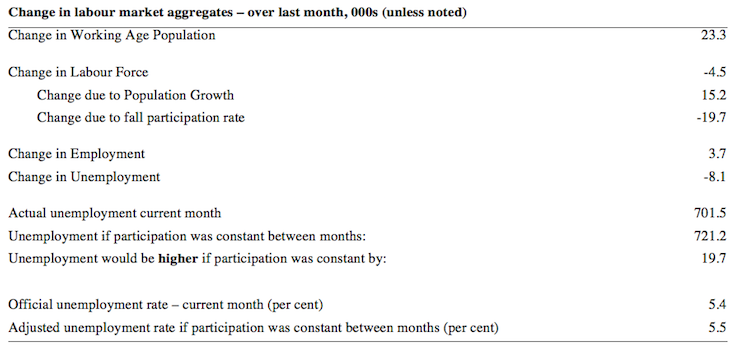
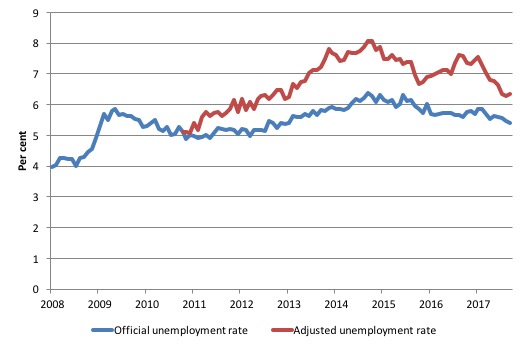
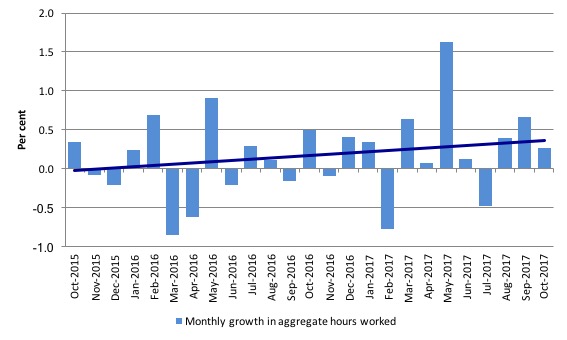
This Post Has 0 Comments